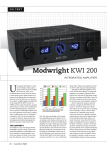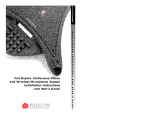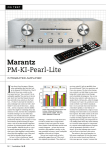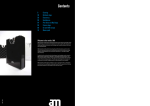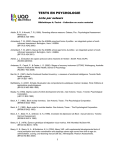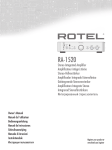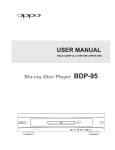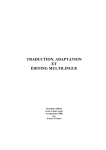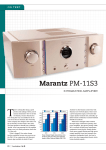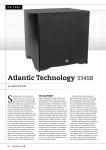Download HF May12_024 Test Rotel.indd
Transcript
ON TEST Rotel RA-1520 INTEGRATED AMPLIFIER R otel has recently changed. It has a brand-new factory in Zhuhai, China, a new design team and a new vision for its amplifiers that means we’ll be seeing some modern, stylish exteriors on Rotel componentry that’s to come. Mike Bartlett, the Executive Vice President of Rotel, told me that he’s so serious about changing the brand that he is now living in China to be closer to the factory. Rotel’s lead electronics designer, Darren Orth, also moved to China to head up the new Chinese design team. Only Robert Burn remains in the UK, where Bartlett says he will continue to ‘have the final word on performance.’ THE EQUIPMENT In terms of industrial design, the RA-1520 has been around a year or two now, and so was designed prior to the new factory and before the new industrial design that first saw light of day on the company’s RDD 06 DAC. Bartlett told me that the RDD 06’s curvy appearance will be re-imagined in a new two-channel amplifier that should be released later this year. Nonetheless the edges of the RA-1520’s front panel are elegantly curved and the front panel has a stylish brushed aluminium finish, 24 so it’s a long way from the ‘black beasts’ Rotel built back in the ‘70s and ‘80s. The Rotel RA-1520 is a linear Class-AB amplifier with a conventional power supply that’s rated at 60-watts per channel, but has a sticker price that’s only just into four figures. However, like pretty-much every Rotel amplifier I’ve ever heard of (and the company traces its history back 50 years!) the power output specification is conservative, with Newport Test Labs finding that our review sample delivered nearly 100-watts per channel at 1kHz when both channels were driven into 8Ω (For the full suite of test results, see the Laboratory Test Report on page 60). The reason Rotel isn’t using a Class-D output stage is pretty much down to Michael Bartlett’s own philosophy about music. In a recent interview he told me: ‘I like to hear music either via Class-A or Class A/B amplification because I think I hear a better result—the music just seems to flow better.’ In addition to using ‘traditional’ output stages, Rotel also seems to be re-introducing ‘traditional’ bass and treble tone controls, because here they are making an appearance on the RA-1520. As I pointed out in a recent review of a Marantz amplifier that had tone controls, the reason audiophiles don’t like tone controls… and therefore why amplifier manufacturers stopped fitting them to their amplifiers… is based on a false premise. That premise was that tone controls are inherently ‘bad’. But they’re not! Sure, back in the ‘70s and ‘80s, there were quite a few ‘cut-price’ tone control circuits around that didn’t work properly, and it was these circuits that were the reason tone controls got a bad name. But that’s no longer the case—modern tone controls now use sophisticated circuits that boost (and cut) only those frequencies that require it and leave all other frequencies untouched. Rotel is having a bet both ways with the RA-1520, because in addition to offering tone controls for those who want them, it also provides a tone defeat button that can be used to remove them completely from the circuit if that’s your preference. My only gripe with the bass and treble controls is that they have a kind of rough silvery coating applied that didn’t look too flash. (The same rough silvery finish is used on the other rotaries, but because they’re physically larger, the finish works better on them.) Surely it couldn’t cost that much more to apply a nicer finish? Australian HF May12_024 Test Rotel.indd 24 9/05/2012 12:11:10 PM Rotel RA-1520 Integrated Amplifier To the left of the bass and treble controls you’ll find a speaker selector that allows you to connect two pairs of speakers to the amplifier and play only the pair in your main listening room (A), a second pair (B) somewhere else in your home (maybe another room, or outside), both pairs together (party!) or turn the speakers off entirely (for listening via headphones). The headphone socket is immediately alongside the speaker selector and is, unfortunately, a 3.5mm size, presumably to match the 3.5mm Power Output: Single channel driven into 8-ohm, 4-ohm and 2-ohm non-inductive loads at 20Hz, 1kHz and 20kHz. ‘Media Player’ input above it. I don’t find 3.5mm phone sockets are mechanically very strong: I far prefer the larger 6.5mm phone jacks. The ‘Media Player’ socket on the front panel has been specifically included so you can plug in your portable iDevice, phone or MP3 player. Initially I couldn’t work out how to select the Media Player input, because there isn’t a ‘Media Player’ setting on the Source Selector switch. It turned out you have to select the Source Selector switch to ‘Aux’. This selects the rear panel ‘Aux’ input unless you have a 3.5mm jack inserted into the Media Player socket, in which case the rear-panel input is disabled. I would have preferred an additional position on the Source Selector, but I guess it’s not a biggie. The source selector has positions for Phono, Tuner, CD, Aux, Tape 1 and Tape 2. Curiously enough, the RA-1520 also has a ‘Recording’ selector (sometimes known as a Record Output selector). It allows you to choose the signal that will appear at the record output terminals on the rear panel and has positions for Tape 1, Tuner, CD, Aux and Phono. This means that the RA-1520 can be processing two different audio signals simultaneously. For example you could be playing an LP and sending the signal to the record outputs, which could in turn be connected to your computer, effectively allowing you to digitise your LPs, while at the same time you could be listening to a CD through the speakers. The large rotary volume control that dominates the front panel is motorised, which means it has a ‘dead’ feel under the fingers that I didn’t particularly like, but I guess that in these couch-potato times, if Rotel did not offer the convenience of remote control on the RA-1520, it would be signing the amp’s death warrant in terms of sales (at least to consumers unaware of Rotel’s audiophile history). The rear panel has all the standard fittings, all of which are gold-plated including the good-sized speaker terminals, but I was a little annoyed to find that the centres of the speaker terminals are spaced just a little wider than the usual 19mm, which means that you can’t use dual banana plugs, so it’s either individual banana-plug-equipped speaker cables, spade connectors or back to bare wire. IN USE AND LISTENING SESSIONS When I unpacked the Rotel RA-1520 I discovered that Rotel is seriously committed to building sensibly- ON TEST ROTEL RA-1520 INTEGRATED AMPLIFIER Brand: Rotel Model: RA-1520 Category: Integrated Amplifier RRP: $1,099 Warranty: Five Years Distributor: International Dynamics Australasia Pty Ltd (IDA) Address: 129 Palmer Street Richmond VIC 3121 1800 456 393 (03) 9426 3600 (03) 9426 3655 [email protected] www.internationaldynamics.com.au • High power output • Phono stage • Tone controls • 3.5mm mini-jacks • Speaker post spacing • Finish on tone controls LAB REPORT Readers interested in a full technical appraisal of the performance of the Rotel RA-1520 Integrated Amplifier should continue on and read the LABORATORY REPORT published on page 60. Readers should note that the results mentioned in the report, tabulated in performance charts and/or displayed using graphs and/ or photographs should be construed as applying only to the specific sample tested. Lab Report on page 60 avhub.com.au HF May12_024 Test Rotel.indd 25 25 9/05/2012 12:11:12 PM ON TEST Rotel RA-1520 Integrated Amplifier priced components. One way you can do this is by watching the pennies, and I was immediately able to tell how cost-conscious Rotel’s management was when I opened the plastic bag containing the Operating Manual and discovered two small self-adhesive rings inside with the instruction to ‘Place this selfadhesive ring over the light surrounding the On/ Off push button if the blue light is too bright.’ From this, I deduced that Rotel has had some customers complaining that the light is too bright, while others have not complained: presumably either being happy with the light level as it is or not bothered enough bass—or you can take away some bass from a bass-heavy speaker, or one that has of necessity been positioned in a region of your listening room that results in an accentuated bass response. The treble control can be used to ‘tame’ recordings that have too much of it (many recording engineers have very poor high-frequency hearing, and compensate for it by adding too much treble when they master albums) or to increase treble response to compensate for a tweeter whose highfrequency response rolls off prematurely (and that’s a lot of them!). In the course of reviewing the RA-1520 I did quite a bit of medium-sized listening room without taxing the Rotel’s power reserves, but if you have a very large room filled with soft furnishings, or you regularly throw parties at which you fill your room with guests and have them dance to loud music, you may find yourself reaching the limits of the RA-1520’s notinconsiderable power output capabilities. That excellent performance continued across the midrange, and up into the treble, with the RA-1520 remaining completely transparent to the music, adding nothing and taking nothing away. Channel separation and balance were audibly excellent, with images The abundance of power manifested itself in superbly detailed bass, effortlessly delivered, with a solidity that echoed what you’d hear live performance Power Output: Both channels driven into 8-ohm, 4-ohm and 2-ohm non-inductive loads at 20Hz, 1kHz and 20kHz. RA1520. by it to complain. So, rather than re-design the amplifier, or make it more expensive by adding a light dimmer circuit, Rotel decided on the ‘low-tech’ (zero cost) approach of simply including a small adhesive ring to block out most of the light. If you think the light is too bright, just stick the ring over it. If you’re not bothered by the brightness of the light, there’s no need to do anything at all. If nothing else, this shows one reason why Rotel is able to build high-performance hi-fi equipment at budget prices! When I turned the RA-1520 on, the frontpanel LED glowed red for around two seconds to indicate the amplifier was protecting itself while all the internal circuitry stabilised, which it did accompanied by quite a lot of clicking from the internal relays. The protection also triggers when you turn the amplifier off, no doubt to prevent transients from getting to your loudspeakers. Rotel is obviously playing it safe on your behalf. As for the bass and treble controls, you don’t have to listen to too many CDs to discover that having the ability to adjust bass and treble is no bad thing: in many cases, being able to make minor tonal changes is decidedly advantageous. You can use the bass tone control to add some bass to speakers that are a bit bass-shy—either by design or because you’ve put them in positions in your room in which they can’t deliver maximum 26 fiddling with the bass and treble controls and enjoyed every minute of it, and I suggest that if you end up buying an RA-1520, you adjust the bass and treble controls as well. The only proviso is that if you turn the bass control up beyond about the 3’o’clock position you should not play music at high volume, in order to avoid over-powering your bass drivers. It’s because of the tendency to increase overall volume without returning the bass control to the ‘detent’ position that the automatic variable loudness contour was developed… though one doesn’t make an appearance on the RA-1520. Nor does any form of ‘loudness’ control, for that matter. One interesting point to note is that if you leave the tone controls in their centre ‘detent’ position and press the tone control button on and off, you’ll hear a difference in the level of the sound. This is because activating the tone control circuit gives a slight increase in volume at the speaker outputs. It’s not important, and makes no difference whatsoever to the amplifier’s performance, but it’s worth of note. You certainly won’t have to increase the bass tone control to get low-frequency ‘oomph’ from the RA-1520, because it has all the power and extension in the bass you will need to get the most from even the largest floor-standing speakers. It’s a controlled delivery, too. Bass notes are given just the right weight and volume, and the notes are controlled right from the outset until the end, so there’s no unwanted overhang that could cause the bass to ‘bloom’ and become loose and flabby. Everything is kept tight and restrained. Tonal accuracy is outstanding as well, so even down deep you’ll always hear the unique tonal characteristic of the instrument that’s being played, rather than some undefined fundamental. Using efficient (89dBSPL) speakers I could quite easily reach levels that were simply too loud for my appearing exactly where they should across the soundstage. When there was a central image, it appeared at the exact centre-point between the speakers, as it should. And when sounds appeared in only one channel, there was no leakage at all to the other channel… again exactly as it should be. I was lucky enough to be auditioning the RA-1520 at the same time Melbourne’s Melba Recordings released an absolutely superb new CD titled ‘A Lotus Blooming’, which has the Ensemble Liaison (David Griffiths (clarinet); Svetlana Bogosavljievic (cello) and Power Output: Single and both channels driven into 8-ohm, 4-ohm and 2-ohm non-inductive loads at 20Hz, 1kHz and 20kHz. Timothy Young (piano) playing Alexander Zemlinsky’s Trio for Clarinet, Cello and Piano and Olivier Messiaen’s Quartet for the End of Time (joined for the latter by Wilma Smith). I can’t say I went much for Zemlinsky’s Trio (though the liner notes say that concentrated listening is required to ‘grasp the full extent of the music’s virtuosity’) but Messiaen’s Quartet for the End of Time had me captivated from the outset. It’s a stunning work and this performance of it is simply outstanding. Australian HF May12_024 Test Rotel.indd 26 9/05/2012 12:11:12 PM ON TEST Rotel RA-1520 Integrated Amplifier All four musicians give perfect individual performances, whilst also performing as a perfect quartet. Smith integrates with the established trio as if she’d been playing with them for years (listen carefully during Danse de la fureur… , as just one example, to hear the perfection in the timing, weight and the balance of each instrument against the others) and her playing is not only a technical tour-de-force but also an emotional one. Listening to her play, I could almost visualise the premiere of this work in Stalag VIII in January 1941. I can do no better than quote the liner notes: ‘Seventy years hence, Messiaen’s profound music has lost nothing of its effect. It remains a uniquely fresh, breathtaking, and, above all, astonishing work of art.’ Happily I can report that just as the musicians have excelled themselves, so too has the recording engineer, Alex Stinson. The recording (Melba MR301132) has a crystalline clarity and is wonderfully dynamic, with a quiet (yet not ‘black’ background) and not an unwanted extraneous sound anywhere. A disc for music lovers and audiophiles alike. If you’re not already a fan of Messiaen, this will have you singing his praises. The Rotel RA-1520 did its part by letting me hear everything as clearly as it was recorded, and with the same dynamics, and without undue emphasis on any part at the expense of another. Most particularly I revelled in the way the Rotel reproduced the just-perceptible scrape of violin bow over string, as if the sound were issuing from some nether world. It made my entire listening experience surreal, just as I think Messiaen intended. And if you’re wondering, I didn’t bother pasting the light-blocking ring over the power button but I agree that it’s very bright! CONCLUSION I guess you could argue that including bass and treble controls which only some people will use—not to mention a balance control that only a few people will ever use—adds to the cost of the amplifier, but it wouldn’t be much, and when you balance this with the low price and the excellent sonic performance, Rotel’s RA-1520 amplifier really is superb value for money. Rotel may well be heading in a new direction, but it’s using the same rudder that’s successfully steered it through 50 years of success stories, so you’ll be in safe hands. I can only wait with bated breath for that new two-channel amplifier Mike Bartlett said was ‘to come’ and perhaps hold the Messiaen in reserve to celebrate the greg borrowman occasion. LAB REPORT ON PAGE 60 Equipment Reviews“ on Zinio Voted ‘THE BEST OF THE BEST’ Hi-Fi + 2011 Australian Hi-Fi Magazine's most recent equipment N... SHINE O Power for digitally, Hi-Fi from Zinio, so you reviewsConditioners are now available can buy an individual electronic copy of the magazine and Home Cinema use! containing the review you want, for just $4.49. Each copy of the magazine you download will contain at least three additional reviews, plus a variety of feature articles and music reviews. The following recent equipment reviews are currently available via Zinio. EETER ND TW DIAMO B&W ’S FF THE 802 TOPS O 5 ! Reviews + ne DD-15 • Velody 802 • B&W tWave io Perfec • PS Aud Lite tz Pearl • Maran 0 250 Move • Pure Aaron ort Show Repal Audio Show UK Nation Farewell C D! S Wil O’ ma PS AUDIlMB Ojor labels kill the compact CD CO L disc? TICKS AL S XE THE BO Nov/Dec 2011 Jan/Feb REVIEWED Olld d is new! w io KR Aud made… ves are How val 2012 $7.95 Aaron XX Amplifier Atlantic Tech nology 444SB Sub JBL Studio 130 Speakers Oppo BDP95 BD Player Technical Brain Zero Pre/P ower $7.95 011 4:17:26 PM 19/12/2 12_001 HF JanFeb Cover.indd 1 HF NovDec11 _001 Cover.indd 1 HI-FI SH SHO HOW OW 2011 20 011 30/11/2011 12:07:33 PM • Marantz SA KI Pearl Lite SACD Player • Aaron XX 20th Anniversary Integrated Amp • Moon Evolution 700i Integrated Amplifier • Atlantic Technology 334SB Subwoofer • Oppo BDP-95 Blu-ray Universal Disc Player • Atlantic Technology 444SB Subwoofer (Also Free Download from www.avhub.com.au) • Atohm GT 1.0 Loudspeakers • Orpheus Apollo VI Loudspeakers • B&W 802 Diamond Loudspeakers Hi Fi World Sirius Solus Sigmas Wave Transport Aquarius • PS Audio Perfect & DAC • Bel Canto C5i Integrated DAC/Amplifi er 5 Globe Winner 2011 • Move 2500 Portable DAB+ Radio • Berkeley Audio Design Alpha DAC • Technical Brain TBC-Zero/TBP-Zero Pre/Power Amplifiers • JBL Studio 130 Loudspeakers (Also Free Download AVAILABLE VIC: NSW: QLD: • VAF Signature i90 Loudspeakers from www.avhub.com.au) FROM Just Klapp Secher Audio Krispy Kables AV Design • Velodyne Digital Drive DD-15+ SubwooferTownsville, QLD • JBL Sub 150P Subwoofer (Also FreeVIC Download from 72-74 Chapel St.Prahran, VisualCamberwell, VIC Berowra Heights, NSW • Whatmough P33i Loudspeakers Tel: 07 4772 3470 www.avhub.com.au) Tel: 03 9529 5966 Tel: 03 9830 4585 Tel:Signature 02 8006 4666 www.justklapp.com www.krispykables.com.au www.avdesign.com.au • Marantz PM-KI-Pearl-Lite Int Amplifier (Alsowww.secheraudio.com.au Free Download from www.avhub.com.au) GrooveWorks Australia Focus Sound & Vison Knox Audio Neerim South, VIC 381 Victoria St, Abbotsford, VIC Woronora Heights NSW Tel: 03 5628 4428 Tel: 03 9427 8638 Tel: 02 9542 2998 To downloadwww.recordclean.com.au any of these reviews, type www.tinyurl.com/Equip-Reviews-1 into your browser, then click on www.focussoundvision.com.au www.knoxaudio.com.au the link to the review you want. (Zinio's electronic platform supports Android, Windows 7, WebOS, iOS, and Air.) 28 Australian Absolute Hi End www.absolutehiend.com IsoTek HFMay12.indd 3 HF May12_024 Test Rotel.indd 28 HIFI Clients.indd 3 27/03/2012 11:23:13 11:24:32AM AM 10/05/2012 6/03/2012 2:06:37 PM LAB REPORT Rotel RA-1520 Integrated Amplifier CONTINUED FROM PAGE 24 TEST RESULTS Talk about understating power output! Rotel rates the RA-1520 at just 60-watts per channel, but Newport Test Labs measured its output at 95-watts per channel at 1kHz when both channels were driven into 8Ω loads. When only a single channel was driven, the RA1520 delivered almost double its rated power into 8Ω, returning a figure of 110-watts (single channel). However it appears from the table showing the complete set of power output results that Rotel has deliberately configured its protection circuit to limit the continuous power available in situations where the amplifier’s output devices might be damaged. So at 20kHz, for example, the continuous power output is limited to 60-watts when driving 8Ω loads, and 100-watts when driving 4Ω and 2Ω loads. Note that these are continuous figures. When playing music, which is transient in nature, the protection circuit would not trigger, so I’d expect that the amplifier would deliver the same power it would at that frequency as it would at 1kHz. I should also point out that you’ll never, ever, have any amplifier deliver more than a few watts of power up at 20kHz… you’d fry your tweeter in an instant! The reason the 20kHz measurements are performed by Newport Test Labs is designed to test the outer limits of the capabilities of an amplifier’s output devices. You can see from the asterisks on the Power Output Table that the protection also triggered when the amplifier was driving 2Ω loads (for which it is not rated, as you can see from the warning sticker on the rear of the amplifier) but look at the power levels at which it triggered: at 100-watts continuous both channels driven at 20Hz, at 144-watts per channel at 1kHz and at 100-watts per channel at 20kHz… and all into 2Ω loads. Most equivalently-priced amplifiers (and more than a few that are far more expensive) would simply shut down when presented by such a low impedance. Also note that unlike most protection circuits, the one fitted to the Rotel RA-1520 automatically resets itself. So if it triggers, you only have to wait a few seconds and the amplifier will re-start itself. (In other words, you don’t have to turn the amplifier off then back on as you do with most other electronic protection circuits.) Total harmonic distortion (THD) was very low at both 1-watt and at rated output, as you can see by Graphs 1–4. Graph 1 shows distortion at one watt into 8Ω and you can see there’s a second harmonic at –90dB (0.0031%), a third harmonic at –110dB (0.0003%), a fourth harmonic at –100dB (0.001%) and a sixth at –108dB (0.0003%). (The fifth harmonic component is buried beneath the noise floor, which hovers around –115dB (0.0001%.) This is excellent performance and the total THD+N summed figure came in at 0.01%. Dropping the load impedance to a more-difficult-to-drive 4Ω saw a slight increase in distortion, with the second harmonic component rising to –84dB/0.006% (though this is a ‘goodsounding’ component), and the fourth and sixth components to –94dB (0.0019%) and –98dB (0.0012%) respectively. Rotel RA-1520 Integrated Amplifier — Power Output Table Channel Load (Ω) 20Hz (watts) 20Hz (dBW) 1kHz (watts) 1kHz (dBW) 20kHz (watts) 20kHz (dBW) 1 8Ω 100 20.0 110 2 8Ω 83 19.2 95 20.4 60* 17.8 19.7 60* 1 4Ω 162 22.0 17.8 178 22.5 100* 20.0 2 4Ω 108 1 2Ω 184* 20.3 141 21.5 100* 20.0 22.6 220* 23.4 100* 20.0 2 2Ω 100* 20.0 144* 21.5 100* 20.0 Note: Figures in the dBW column represent output level in decibels referred to one watt output. *Protection triggered at this power output level. (Auto resetting circuitry, see copy.) Rotel RA-1520 Integrated Amplifier — Test Results Test Frequency Response @ 1 watt o/p Frequency Response @ 1 watt o/p Channel Separation (dB) Channel Balance Units/Comment 10Hz – 100kHz –1dB 4Hz – 100kHz –3dB 88dB / 63dB / 38dB 0.059 (20Hz / 1kHz / 20kHz) dB @ 1kHz Interchannel Phase 0.09 / 0.07 / 1.17 degrees ( 20Hz / 1kHz / 20kHz) THD+N 0.01% / 0.005% @ 1-watt / @ rated output Signal-to-Noise (unwghted/wghted) 80dB / 84dB dB referred to 1-watt output Signal-to-Noise (unwghted/wghted) 88dB / 98dB dB referred to rated output Input Sensitivity (CD Input) Output Impedance Damping Factor 60 Measured Result 24mV / 183mV (1-watt / rated output) 0.02Ω OC = 353 @1kHz Power Consumption 2.96 / 28 Power Consumption 54 / 252 Mains Voltage Variation during Test 246 – 251 Heatsink Temperature (Degrees C) 53.5 V watts (Standby / On) watts at 1-watt / at rated output Minimum – Maximum @ 1-watt and 5-watts output Australian HF May12_024 Test Rotel.indd 60 9/05/2012 12:06:24 PM LAB REPORT Rotel RA-1520 Integrated Amplifier When power delivery was upped to maximum 60-watts into 8Ω, overall distortion increased, but the level of the low-order harmonic distortion components didn’t change all that much. Instead, we see the appearance of higher-order components at 8kHz, 10kHz, 12kHz etc. Note again that these are even-order harmonics, which will give a better ‘sound’ than odd-order harmonics. The ‘spike’ at 15kHz is not related to the amplifier’s performance, but is interference from a near-by cathode ray tube, and so should be ignored. Performance at 100-watts into 4Ω followed a similar pattern to the 8Ω test. Note that although the distortion components look visually ‘taller’ on the graphs, this is an optical illusion dBFS 0.00 Newport T Test est Labs -20.00 -40.00 -60.00 -80.00 -100.00 -120.00 -140.00 0.00 Hz 4000.00 8000.00 12000.00 16000.00 20000.00 Graph 1: T Total harmonic distortion (THD) at 1kHz at an output of 1-watt across an 8-ohm non-inductive load, referenced to 0dB. [Rotel RA-1520 Integrated Amplifier] caused by the fact that the noise floor has dropped by almost 10dB. Noise itself was relatively low, returning figures of 80dB unweighted and 84dB ‘A’weighted referred to an output of one watt (so you can compare noise figures with any other amplifier, irrespective of its power output) and 88dB unweighted and 98dB ‘A’-weighted referred to 60-watts. You can see from the spectrograms that the noise is almost entirely low-frequency in nature (evidenced by the trace ‘crawling’ up the side of the graph at the left). At high frequencies, the noise floor is more than 100dB down. Channel separation was fair at low and mid-frequencies, but dropped to a low (though adequate) 38dB at 20kHz. Interchannel phase was not perfect, but with a ‘worst-case’ result of just 1.17° at 20kHz, there’s nothing to worry about here! Frequency response was extended, with the amplifier being –1dB at 10Hz and –3dB at 4Hz at low frequencies. The high-frequency limit was dictated by the Rotel’s protection circuitry, which triggered when the test sweep hit the 100kHz mark. This means the RA-1520 is a very wide-band design, as well as being remarkably flat across the entire bandwidth covered. The frequency dBr 1.00 dBFS 0.00 Newpor Ne wportt T wpor Test est Labs Newport T Test est Labs -20.00 0.50 -40.00 -60.00 0.00 -80.00 -0.50 -100.00 -120.00 -1.00 10.00 Hz -140.00 0.00 Hz 4000.00 8000.00 12000.00 16000.00 Graph 2: T Total harmonic distortion (THD) at 1kHz at an output of 1-watt across a 4-ohm noninductive load, referenced to 0dB. [Rotel RA-1520 Integrated Amplifier] dBFS 0.00 Newport T Test est Labs 100.00 1000.00 10000.00 30000.00 Graph 5: Frequency response of line input referenced to a 1 watt output (at 0dB) across an 8 ohm non-inductive load (black trace) and across a combination resistive/inductive/capacitive load representative of a typical two-way loudspeaker system (red trace). 20000.00 dBFS 0.00 Newpor wport T Test est Labs -10.00 -20.00 -20.00 -40.00 -30.00 -40.00 -60.00 -50.00 -60.00 -80.00 -70.00 -80.00 -100.00 -90.00 -120.00 -100.00 -110.00 -140.00 0.00 Hz 4000.00 8000.00 12000.00 16000.00 20000.00 -120.00 0.00 Hz Graph 3: T Total harmonic distortion (THD) at 1kHz at an output of 60-watts across an 8-ohm non-inductive load, referenced to 0dB. [Rotel RA-1520 Integrated Amplifier] dBFS 0.00 4000.00 8000.00 12000.00 16000.00 20000.00 24000.00 28000.00 Graph 6: Intermodulation distortion (CCIF-IMD) using test signals at 19kHz and 20kHz, referenced to a 1-watt output (at 0dB) across an 8-ohm non-inductive load. [Rotel RA-1520 Int. Amplifier] Newport T Test Labs dBr 10.00 Newpor Ne wport T wpor Test est Labs -20.00 5.00 -40.00 0.00 -60.00 -5.00 -80.00 -10.00 -100.00 -15.00 -120.00 -140.00 -20.00 0.00 Hz 4000.00 8000.00 12000.00 16000.00 20000.00 Graph 4: T Total harmonic distortion (THD) at an output of 120-watts across a 4-ohm non-inductive load, referenced to 0dB. [Rotel RA-1520 Integrated Amplifier] 62 10.00 Hz 100.00 1000.00 10000.00 Graph 7: T Tone control action referenced to 0dB at 1kHz. [Rotel RA-1520 Integrated Amplifier] response across the audio band is shown in Graph 5. There are two traces: one into a standard non-inductive laboratory dummy load (the black trace) and the other into a load that simulates that of a small twoway loudspeaker. You can see that in both instances, the low-frequency response starts rolling off at 70Hz to be 0.2dB down at 20Hz. Normalised, this puts the frequency response at 20Hz to 20kHz ±0.1dB. The tiny differences between the two traces mean that the Rotel will quite happily drive any load, and that it will sound the same no matter what speakers you connect. Its ability to drive 2Ω loads means you can even use speakers with a reputation for being ‘tough’ to drive. The Rotel performed particularly well in the CCIF-IMD test. As you can see from Graph 6, there are only two high-frequency side-bands either side of the twin test signals (at 19kHz and 20kHz), and both are more than 100dB down (0.001%). There is a very small 1kHz signal regenerated, but it’s at around –95dB, contributing only 0.0017% to the signal, so would be completely inaudible. Tone control action was a little unbalanced, with each control giving only around 6dB of boost, but a good deal more ‘cut’ (nearly 15dB of reduction at 20Hz, for example). The boosted sections show that the tone control circuit includes shelving, so you can’t ‘overboost’ the response too much, which is excellent (and safe!) design. The only minor failing I can see is that the controls’ boost and cut action extends a bit further into the midrange frequency area than I might have liked, so when you use the controls to boost or cut the bass or treble, you’ll also affect midrange frequencies. The oscillograms showing square wave performance are interesting. The 100Hz wave shows the expected tilt caused by the non-d.c. response, but also that there is no phase shift, which is excellent. The 1kHz wave is excellent, but the overshoot shows there is a peak in the Rotel’s frequency response at ultrasonic frequencies (up at 100kHz). This overshoot is also visible on the 10kHz square wave. This latter waveform, however, is excellent, revealing the extremely wide bandwidth of the amplifier. The 1kHz response into a reactive load shows quite a bit of ringing, but this is a combination of the overshoot mentioned previously and the load itself. Overall, the amplifier will be completely stable into any loudspeaker load, including one such as an electrostatic speaker. Output impedance was just 0.02Ω (at 1kHz) giving, in turn, a very high damping factor of 353, which means the Rotel RA-1520 will be able to keep control over even the largest-diameter bass drivers. Stand-by mains power consumption was slightly higher than the mandated twowatts, and increased to 252-watts when the Steve Holding amplifier is driven hard. Australian HF May12_024 Test Rotel.indd 62 9/05/2012 12:06:57 PM






